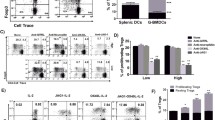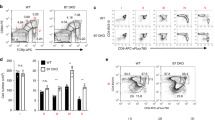Abstract
Aims/hypothesis
Weak stimulation of CD4+ T cells induces expansion of CD4+ forkhead box P3+ regulatory T cells (Tregs) and can also promote T helper (Th) 2 responses, which have demonstrable beneficial effects on autoimmune diabetes. This study explored the feasibility of combined Treg/Th2 expansion for immunotherapy of type 1 diabetes in NOD mice.
Methods
We compared Treg and Th responses to dendritic cells (DC) presenting scaled antigen doses to islet-specific NOD CD4+ T cells. Flow cytometric and Luminex analyses were performed to determine the phenotype and cytokine profile of expanded T cells. The ability of expanded T cells to prevent type 1 diabetes was tested in an adoptive transfer model.
Results
In vitro studies revealed a hierarchical, selective expansion of Treg and T effector (Teff) populations at different antigen doses. Thus, a single low dose produced a mixture of Tregs Th2 and type 1 regulatory (Tr1) cells, which prevented diabetes in NOD-SCID mice and increased the ratio of Treg/Teff cells infiltrating the pancreatic islets. Subcutaneous injection of DC, previously shown to prevent diabetes in NOD mice, induced expansion of the same mixture of Tregs Tr1 and Th2 cells. Low-dose expansion of Treg required MHC–T cell receptor interaction and was partly dependent on T cell derived TGF-β and IL-2. Autocrine IFN-γ was required for the promotion of diabetogenic Th1 cells at high antigen doses.
Conclusions/interpretation
Weak stimulation of CD4+ T cells with DC and low-dose antigen expands a combination of antigen-specific Tregs Th2 and Tr1 cells that prevent autoimmunity, without the need to target or purify specific Treg populations.





Similar content being viewed by others
Abbreviations
- Ag:
-
Antigen
- BM:
-
Bone marrow
- CFSE:
-
Carboxyfluorescein diacetate succinimidyl ester
- DC:
-
Dendritic cells
- FOXP3:
-
Forkhead box P3
- GM-CSF:
-
Granulocyte−macrophage colony-stimulating factor
- LN:
-
Lymph node
- mAb:
-
Monoclonal antibody
- mTOR:
-
Mammalian target of rapamycin
- PI3K:
-
Phosphoinositide 3-kinase
- pMHC:
-
Peptide/MHC
- STAT:
-
Transducer and activator of transcription
- TCR:
-
T cell receptor
- Teff:
-
T effector
- Tg:
-
Transgenic
- Th:
-
T helper
- Treg:
-
Regulatory T cell
- Tr1:
-
Type 1 regulatory cell
References
Shimizu J, Yamazaki S, Sakaguchi S (1999) Induction of tumor immunity by removing CD25+ CD4+ T cells: a common basis between tumor immunity and autoimmunity. J Immunol 163:5211–5218
Wing K, Fehérvári Z, Sakaguchi S (2006) Emerging possibilities in the development and function of regulatory T cells. Int Immunol 18:991–1000
Haxhinasto S, Mathis D, Benoist C (2008) The AKT-mTOR axis regulates de novo differentiation of CD4+ Foxp3+ cells. J Exp Med 205:565–574
Sauer S, Bruno L, Hertweck A et al (2008) T cell receptor signaling controls Foxp3 expression via PI3K, Akt, and mTOR. Proc Natl Acad Sci U S A 105:7797–7802
Delgoffe GM, Kole TP, Zheng Y et al (2009) The mTOR kinase differentially regulates effector and regulatory T cell lineage commitment. Immunity 30:832–844
Lee K, Gudapati P, Dragovic S et al (2010) Mammalian target of rapamycin protein complex 2 regulates differentiation of Th1 and Th2 cell subsets via distinct signaling pathways. Immunity 32:743–753
Turner MS, Kane LP, Morel PA (2009) Dominant role of antigen dose in CD4+ Foxp3+ regulatory T cell induction and expansion. J Immunol 183:4895–4903
Leiter EH, Prochazka M, Coleman DL (1987) Animal model of human disease, the nonobese diabetic (NOD) mouse. Am J Pathol 128:380–383
Feili-Hariri M, Dong X, Alber SM, Watkins SC, Salter RD, Morel PA (1999) Immunotherapy of NOD mice with bone marrow-derived dendritic cells. Diabetes 48:2300–2308
Feili-Hariri M, Falkner DH, Gambotto A et al (2003) Dendritic cells transduced to express IL-4 prevent diabetes in nonobese diabetic mice with established insulitis. Hum Gene Ther 14:13–23
Feili-Hariri M, Falkner DH, Morel PA (2002) Regulatory Th2 response induced following adoptive transfer of dendritic cells in prediabetic NOD mice. Eur J Immunol 32:2021–2030
Judkowski V, Pinilla C, Schroder K, Tucker L, Sarvetnick N, Wilson DB (2001) Identification of MHC class II-restricted peptide ligands, including a glutamic acid decarboxylase 65 sequence, that stimulate diabetogenic T cells from transgenic BDC2.5 nonobese diabetic mice. J Immunol 166:908–917
Isse K, Grama K, Abbott IM et al (2010) Adding value to liver (and allograft) biopsy evaluation using a combination of multiplex quantum dot immunostaining, High-resolution whole-slide digital imaging, and automated image analysis. Clin Liver Dis 14:669–685
Turnquist HR, Zhao Z, Rosborough BR et al (2011) IL-33 expands suppressive CD11b+ Gr-1int and regulatory T cells, including ST2L+ Foxp3+ cells, and mediates regulatory T cell-dependent promotion of cardiac allograft survival. J Immunol 187:4598–4610
Haase C, Ejrnaes M, Juedes AE, Wolfe T, Markholst H, von Herrath MG (2005) Immunomodulatory dendritic cells require autologous serum to circumvent nonspecific immunosuppressive activity in vivo. Blood 106:4225–4233
Hosken NA, Shibuya K, Heath AW, Murphy KM, O’Garra A (1995) The effect of antigen dose on CD4+ T helper cell phenotype development in a T cell receptor-alpha beta-transgenic model. J Exp Med 182:1579–1584
Rabinovitch A, Suarez-Pinzon WL (2007) Roles of cytokines in the pathogenesis and therapy of type 1 diabetes. Cell Biochem Biophys 48:159–163
Afkarian M, Sedy JR, Yang J et al (2002) T-bet is a STAT1-induced regulator of IL-12R expression in naive CD4+ T cells. Nat Immunol 3:549–557
Fisson S, Djelti F, Trenado A et al (2006) Therapeutic potential of self-antigen-specific CD4+ CD25+ regulatory T cells selected in vitro from a polyclonal repertoire. Eur J Immunol 36:817–827
Tarbell KV, Petit L, Zuo X et al (2007) Dendritic cell-expanded, islet-specific CD4+ CD25+ CD62L+ regulatory T cells restore normoglycemia in diabetic NOD mice. J Exp Med 204:191–201
O’Gorman WE, Dooms H, Thorne SH et al (2009) The initial phase of an immune response functions to activate regulatory T cells. J Immunol 183:332–339
Kim HP, Kelly J, Leonard WJ (2001) The basis for IL-2-induced IL-2 receptor alpha chain gene regulation: importance of two widely separated IL-2 response elements. Immunity 15:159–172
Constant S, Pfeiffer C, Woodard A, Pasqualini T, Bottomly K (1995) Extent of T cell receptor ligation can determine the functional differentiation of naive CD4+ T cells. J Exp Med 182:1591–1596
Caretto D, Katzman SD, Villarino AV, Gallo E, Abbas AK (2010) Cutting edge: the Th1 response inhibits the generation of peripheral regulatory T cells. J Immunol 184:30–34
Chang J-H, Kim Y-J, Han S-H, Kang C-Y (2009) IFN-γ-STAT1 signal regulates the differentiation of inducible Treg: potential role for ROS-mediated apoptosis. Eur J Immunol 39:1241–1251
Molinero LL, Miller ML, Evaristo C, Alegre ML (2011) High TCR stimuli prevent induced regulatory T cell differentiation in a NF-kappaB-dependent manner. J Immunol 186:4609–4617
Lighvani AA, Frucht DM, Jankovic D et al (2001) T-bet is rapidly induced by interferon-gamma in lymphoid and myeloid cells. Proc Natl Acad Sci U S A 98:15137–15142
Kaur S, Sassano A, Joseph AM et al (2008) Dual regulatory roles of phosphatidylinositol 3-kinase in IFN signaling. J Immunol 181:7316–7323
Long SA, Rieck M, Tatum M et al (2011) Low-dose antigen promotes induction of FOXP3 in human CD4+ T cells. J Immunol 187:3511–3520
Acknowledgements
The authors thank D. Falkner, H. Sun, L. Chedwick and W. Wang (University of Pittsburgh, Pittsburgh, PA, USA) for technical assistance.
Funding
This work was supported by the American Diabetes Association (grant No. 1-06-RA-94 to PAM) and the National Institutes of Health (grant No. R00HL097155 to HRT). MST was supported by a training grant from the National Institutes of Health (No. 5T32 CA82084-10).
Duality of interest
The authors declare that there is no duality of interest associated with this manuscript.
Contribution statement
MST and PAM designed the experiments and MST, KI, DKF and HRT acquired the data. MST, HRT and PAM analysed the data. MST and PAM wrote the manuscript and MST, HRT, DKF and KI provided critical revisions to the content. All authors approved the final version of the manuscript to be published. PAM is the guarantor of this work and, as such, had full access to all of the data in the study and takes responsibility for the integrity of the data and the accuracy of the data analysis.
Author information
Authors and Affiliations
Corresponding author
Rights and permissions
About this article
Cite this article
Turner, M.S., Isse, K., Fischer, D.K. et al. Low TCR signal strength induces combined expansion of Th2 and regulatory T cell populations that protect mice from the development of type 1 diabetes. Diabetologia 57, 1428–1436 (2014). https://doi.org/10.1007/s00125-014-3233-9
Received:
Accepted:
Published:
Issue Date:
DOI: https://doi.org/10.1007/s00125-014-3233-9




